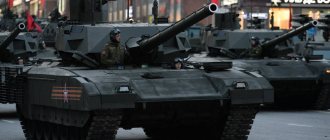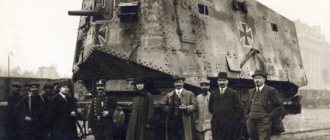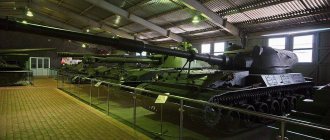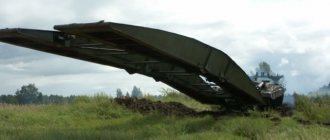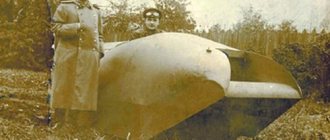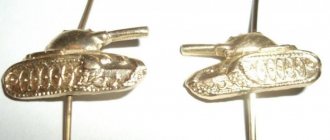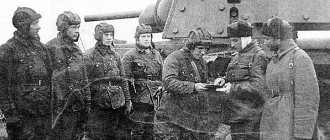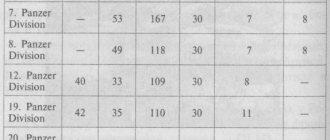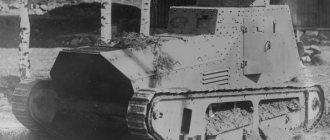Home / Military equipment / Soviet light tank BT-7
BT-7 is a Soviet light wheeled-tracked tank from the period 1930-1940. This is the third tank from the family of the famous Soviet tanks of the BT (high-speed tank) series. It differed from its predecessors, the BT-2 and BT-5 , with a welded hull of a more advanced shape and a new engine.
The vehicle was produced both with armament similar to that of the BT-5 tank, and with a 76-mm cannon.
The latest models of the tank were equipped with a diesel engine. These tanks were produced both with and without a radio station.
A total of 5,328 BT-7 tanks of various modifications were handed over to the troops.
History of the creation of the BT-7 tank
Around January, the Kharkov plant, which at that moment was working on design documentation for the BT-5 tank (Department 520 design bureau), received an order to develop a new tank - the shortcomings that were identified in previous models.
In accordance with the design documentation, it was planned to install a more advanced and reliable M-17 engine on the new tank, develop a welded hull with improved visibility for the driver, install high-capacity fuel tanks and a 76-mm cannon on the tank. In general, the task involved the development of a “long-range, wheeled-tracked attack tank.”
A group of designers took part in the development of the new tank: Firsov, Bondarenko, Morozov, Doroshenko, Kurasov, Veselovsky and Tarshinov.
Already at the beginning of 1934, a prototype was created, which was called BT-7. By May 1, 1934, the first vehicle was ready, and by November 7, 1934, the second model of the BT-7 was created.
On the first two vehicles, a directional machine gun was installed to the right of the driver’s seat, and the turret was made in the form of a truncated cone. A 76-mm KT-28 or PS-4 tank gun could be installed in the turret. It was planned to provide for testing a vehicle with a 45-mm cannon in a standard BT-5 tank turret.
In the fall of 1934, the vehicles underwent a full test program. The military considered that the front-mounted machine gun on the BT-7 was overkill, since the driver was busy driving the tank and was not physically able to fire from the machine gun. In addition, the new turret made it difficult for the machine gun to be compatible with the new turret shape.
As a result, in 1935, serial production of the BT-7 tank began with the already proven turret from the BT-5 tank. At the same time, neither the military nor the designers abandoned the idea of creating a light tank with a 76-mm cannon. In addition, the design bureau received an assignment from the GABTU to develop a BT-7 project, which would allow the installation of a turret from the T-26-4 tank on the vehicle.
Tank BT-7. Model 1935
The serial BT-7 model of 1935 had a rigid box-shaped body with double side walls, a trapezoidal rear part and a rounded, narrowed, elongated front part. The hull was made of steel armor plates, which were connected to each other by welding. Some models had riveted bodies.
The outer walls of the case were removable. The internal walls are 4 mm steel sheets.
The chassis consisted of two guides and eight road wheels. The front pair, when moving on wheels, served to control the tanks, and the rear pair served as drive wheels.
When moving on caterpillar tracks, the steering wheel was removed and placed in the control compartment.
At the rear of the vehicle was a 12-cylinder V-shaped carburetor engine M-17T with a power of 400 hp. Transmission: 4-speed gearbox, multi-disc dry main clutch and side clutches, for wheel drive - guitars, brakes.
Fuel tanks were installed on the sides between the side sheets - 2 pcs. and one tank in the stern.
The tower is cylindrical in shape with a developed aft niche.
Armament: 45-mm 20-K tank gun, model 1934, and coaxial DT machine gun. Some vehicles were equipped with rear machine guns and anti-aircraft machine guns.
71-TK radio stations with handrail antennas were installed on command vehicles.
The crew of the BT-7 tank is three people: the commander and also the gunner, loader and driver.
Tank BT-7. Model 1937
In 1937, serial BT-7 tanks began to be produced with a conical turret, which made it possible (without changing the armament) to increase the tank's ammunition capacity by 44 rounds (for tanks without a radio station - 188 shells, for a tank with a radio station - 145 shells).
All linear BT-7s had DT aft machine guns installed in the rear niche of the turret.
The BT-7 of the 1937 model was equipped with special spotlights of the searchlight type, which were mounted on the gun mantlet, which implied the ability to fire from a cannon and a coaxial machine gun at night. Subsequently, tanks produced before 1937 were also equipped with such headlights.
The gearbox became three-speed, the transmission was improved, and the springs of the balancer suspensions of the drive wheels were strengthened.
Since 1938, vehicles were produced without rubber tires and began to replace the large-link caterpillar with a small-link one.
The frontal armor “grew” to 22 mm, and the combat weight of the vehicle reached 13.9 tons.
Tank BT-7M. Model 1939
Serial production of the BT-7M (sometimes called BT-8) began in December 1939.
Externally, the BT-7M was practically no different from its predecessor BT-7. The main difference is the replacement of the M-17T carburetor engine with the Soviet V-2 diesel engine.
Due to the installation of special braces, the rigidity of the hull was increased, a sub-engine hatch was installed in the bottom of the tank, and the size of the air filter-dust collector cap was changed downwards.
The economical diesel engine made it possible to get rid of fuel tanks above the tracked shelves.
The most important difference is that tanks with diesel engines were significantly safer in battle, since diesel fuel is less flammable if the tank is damaged.
It should be noted that by this time Japanese serial Ha-Go tanks and Type 86 tanks were already equipped with diesel engines. In 1935, diesel tanks began to be produced in Poland - this is the 7TR tank. The French achieved significant success, but cars with diesel engines never went into production.
In Germany, tank diesel engines were not even developed, since it was believed that with the outbreak of hostilities, problems with the production of diesel fuel would inevitably arise.
Light tanks BT-7M were mass-produced until September 1940, even in parallel with the new T-34. Subsequently, all production capacities of the plant were transferred to the production of T-34.
Artillery tank BT-7A
Since 1934, the BT-7A artillery tank with a 76-mm KT-28 cannon was produced in small batches (several vehicles were produced with 76-mm L-11 and F-32 cannons). In total, 154 tanks were produced with a 76 mm cannon.
Links[edit]
Notes[edit]
- BT (Russian: БТ) is the Russian abbreviation for "fast tank" (Bystrokhodny tank, Bystrokhodny tank).
Quotes [edit]
- ^ abcde "Russian fast BT-7 tanks" on wwiivehicles.com
. URL accessed July 25, 2006 - Zaloga 1984, p. 74.
- BT-5, BT-7 and T-50 Tanks of the “Finnish Army 1918-1945”
- Mark Axworthy, Cornel I. Scafe, Cristian Craciunoiu, Third Axis, Fourth Ally: The Romanian Armed Forces in the European War, 1941-1945.
, Page 220 - "Rescuers Who Raise World War II Tanks from the Dead".
- Soviet light tank brigade TO
Combat use of BT-7 tanks
The new Bt-7 tanks were mainly used to equip tank brigades of tank corps and individual tank brigades. BT-7 tanks were initially intended to be used to develop breakthroughs into the depths of enemy defenses.
The BT-7 received its baptism of fire in the battles near Lake Khasan in August 1938. Then BT-7s took part in the battles at Khalkhin Gol, where out of 493 tanks, 48 were lost forever.
In general, the tanks received good reviews, but the difficulty of driving the vehicle was noted, which required excellent training of the driver. And - weak bulletproof armor along with a massive lack of radio stations, which made it difficult to control large groups of tanks in battle.
The BT-7 tank became a symbol of the armored forces of the Red Army, since, along with the identified shortcomings, it had simply excellent maneuverability, speed and “jumping ability”. Armor, rush and firepower.
BT-7s were also used in the battles of the Great Patriotic War. There is an opinion that the tank became obsolete by June 1941, which led to massive losses. However, the use of BT-7 for other purposes than its intended purpose led to massive losses. The BT-7 was not intended for breaking through prepared defenses or oncoming tank battles.
On June 23, 1941, the crew of Sergeant Naidin on a Bt-7 tank destroyed 15 German tanks and 10 artillery pieces in one day. The tank acted suddenly from ambushes. At the same time, he fought with a superior enemy (one against a tank company).
The last time BT-7 tanks took part in battles was in August 1945 as part of the 1st Far Eastern and Transbaikal fronts. And the last stage of the BT-7’s service was the victory parade in Harbin.
Organization and use[edit]
The BT-7A artillery support tank was a self-propelled gun variant armed with a 76 mm howitzer.
A table of the organization and equipment of a typical Soviet light tank brigade in 1939 is as follows:
- 3 tank battalions, each with 3 tank companies with 17 BT-7 or T-26 tanks each;
- 1 signal platoon;
- 1 anti-tank platoon with 3 45 mm anti-tank guns;
- 1 platoon of anti-aircraft machine guns
- 3 motorized rifle companies;
| v those Interwar tanks | |
| |
| Wedges |
|
| Light |
|
| Middle |
|
| Cavalry, cruiser and fast |
|
| Infantry |
|
| Heavy |
|
| Super heavy |
|
| Armored personnel carriers |
|
Tank portal | |
Photo gallery of the BT-7 tank
09 May 2018 admin Tags: military equipment 10461Share this post
- Related Posts
- How the Russians will destroy all American aircraft carriers: American experts named five ways
- PAK FA T-50 vs F-22 Raptor. Virtual fight
- Shield for the Russian nuclear shield complex "Mozyr"
- Legendary Soviet tank KV-1
